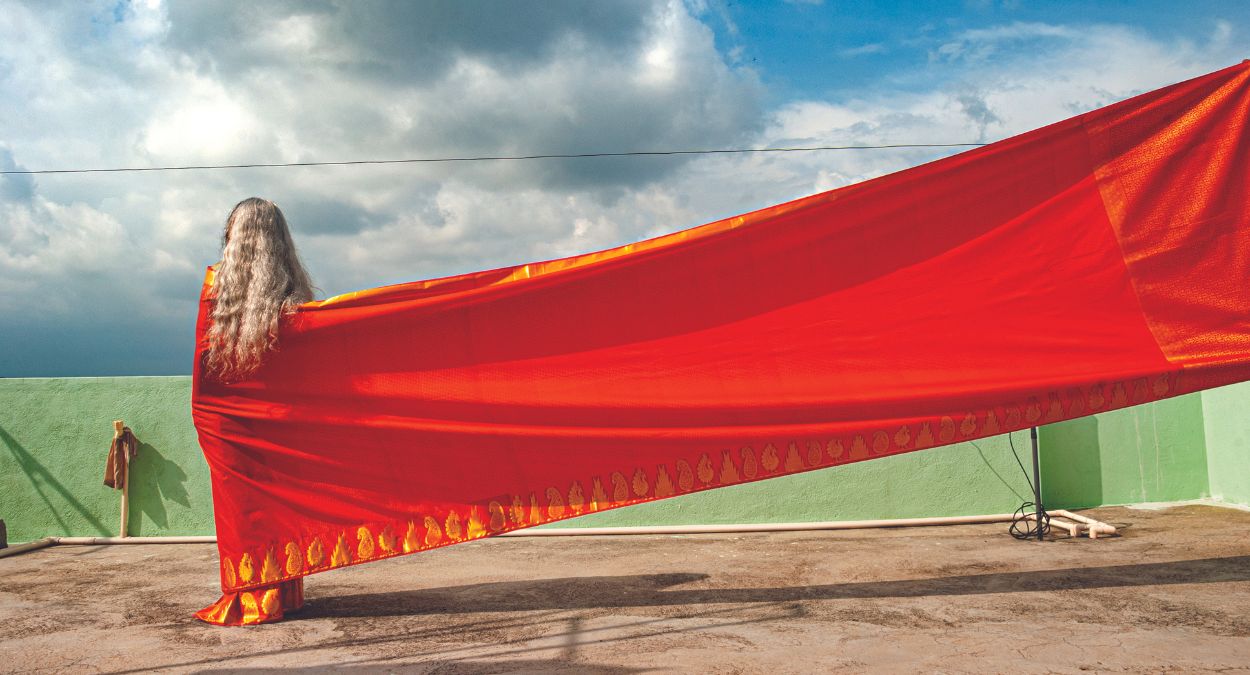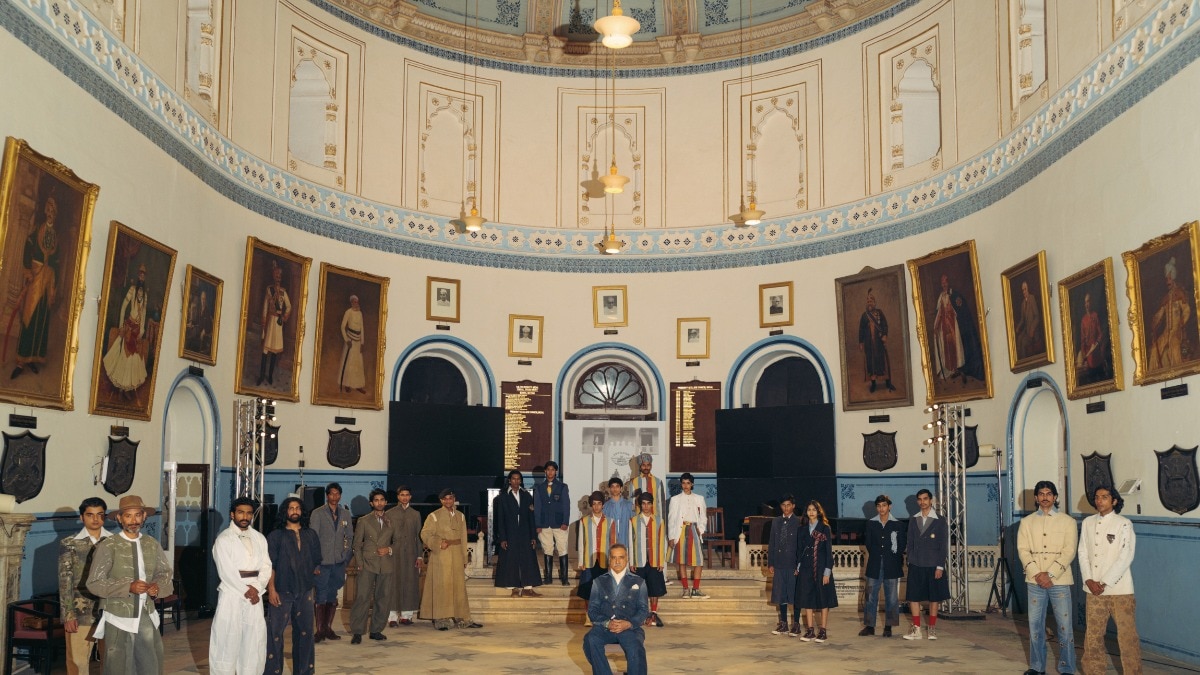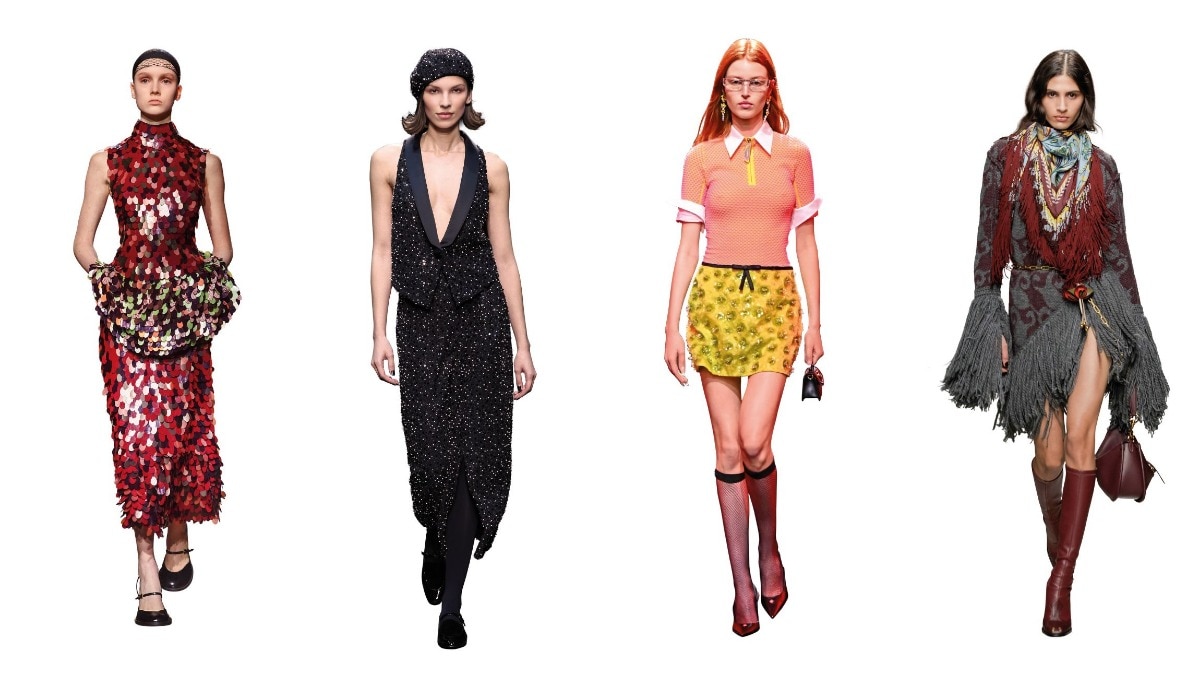An ex-constable captures colours and culture through his lens
In a Bazaar exclusive, Cop Shiva presents iridescent photographs of his mother in her saris that are at once disrupting and enthralling the art scene.


Somewhere in the heart of Karnataka, draped superbly in electric hues of red, green, and gold, a silver-haired queen of saris surveys her kingdom from her bright green palace. The palms of the South wave gently in deference, as the sun paints her ensemble a fiercer orange. The sky is no match for those eight yards of piercing blue, broken only by delicate gold filigree. Her pallu dances with the wind, while her hair strangely stays still. You can’t see her face, but she reels you in all the more because of it.
The lady in the picture is not famous. But she is the world to her son, a constable-turned-self-taught-lensman, who is currently disrupting the art scene around the world with his unwonted ability to deliver a provoking tale through his Promethean vision.
Cop Shiva, as he endearingly refers to himself (a pet name given to him by the artist community), is as colourful as his photographs. This latest series that he has christened Gowri and Her Many Technicoloured Saris is an ode to his mother’s love for her saris and her baal (hair).
“My mom doesn’t wear fancy bangles or flowers... Her saris are not expensive, but each one is carefully chosen from her own village, or when she would visit me in Bengaluru—I would take her to the city market there. Like me, she loves colour,” reveals the 43-year-old artist with gusto. “I am not showing her face here because I wanted the focus to be on her sense of fashion. How delicate her sari collection is, and how fond she is of her hair. My mom is very proud of these two things: she wears a sari every day and combs her hair every day.”
Shot in his hometown Ramanagara, a tiny village that sits approximately 50 kilometres from Bengaluru, and that is famous for lending its sleepy presence in the iconic blockbuster Sholay, Cop Shiva claims that he could not photograph his mother anywhere else because she would not resonate with the place as deeply as she does here. “I didn’t want to take her to the Taj Mahal [to shoot]. She has no idea about these places. I wanted to document my mother’s fashion in the way she likes, and the places that are familiar to her, where she feels she belongs—my village, landscape, my sister’s house...she has many memories of these places, houses, and people. I try to connect with this,” he says.

The photographs are special to the artist because they represent not one but two dreams fulfilled. Hailing from extreme conditions of poverty, Shiva’s mother worked as a coolie to put her son through school while his father, a small farmer, would not contribute to familial needs. “My mother, like most Indian women do for their young (especially in villages like ours), has sacrificed everything for me. She has dreamed about beautiful saris all her life, but she had to make do with borrowing from wealthy neighbours for special occasions,” reveals the cop who only studied till the tenth grade, and began working at the age of 16. “I have given her dream to her, and her photos are a dream to the audience,” he chuckles shyly, also admitting that the verdant edifice his mother so regally stands in, is a recent acquisition. “We had a dream to build a green, two-storey house. We used to dream together while living in an extremely tiny house. In 2017, our second dream finally came to life,” he says, adding that the first floor is his studio, and he plans to paint the house in even brighter shades eventually.
Creativity, it seems, runs in the family. As a wee five-year-old, Shiva remembers spending fascinating nights at local theatres where his grandfather would assume small theatrical roles. “He always told me, ‘Whenever you grow up, don’t take small roles. Go after the big ones’,” he laughs. “At times, I can still picture those nights, the colourful costumes, the make-up, the music, and the scenery,” he reminisces wistfully.

Shiva’s grandfather passed away a couple of years later, requesting his grandson to build a good life for his mother. “My sisters were married off early, or sent to live with my aunt—we simply couldn’t afford anything,” he remembers. “I was a restless child and my mother was my only playmate. She taught me the value of honest, hard work, and I have followed her teachings... It is not easy to work in the forces. You need discipline and dedication,” he says. Shiva joined Bengaluru’s police force at the age of 21, and continued to work through various departments before he took on the role of a coordinator at art space and residency, 1 Shanthiroad, in 2007. Shiva managed over 100 exhibitions and events, and his trained policeman’s eye encouraged his interest in photography. He juggled work with his passion till the urge to spend quality time with his mother took over, and he returned home to pursue it full-time.
“I am very interested in fashion. And I love colours, it is happiness to me,” says the ex-cop whose work has been displayed at the India Art Fair, Chobi Mela, and the Kochi Biennale. “We have this great, vernacular culture, it is very, very bright. In my work, I am addicted to colours and constantly on the hunt for it,” he says.
Shiva’s long-term project, Street Has a Studio, that has been running since 2002, is a living testament to his words. Having completed close to 350 portraits of migrants in front of a government-constructed mural (that was crafted to showcase the glory of Karnataka), he notes that every individual has sported a distinct ensemble, unique to their personality. “In northern Europe, I find that people dress and look the same. Only in India can we play a guessing game of the person’s language, and where s/he is from, based on what they are wearing. This is real fashion to me, not the one that is walked down ramps or exhibited in shopping malls. Fashion is all about individual style that represents the wearer, tradition, colour, and culture.”

As he continues to document the diversity of life within the country through portraiture, Shiva claims he is happy being by himself. The recipient of the 2017 grant of Prohelvetia-Switzerland and Swedish Art Council, he has traversed the world and has no plans of settling down. “I have contributed to raising my sister’s children,” he says unabashedly. “I do not want any more commitments, I am done with it. I love to live with myself, work as an artist, and travel,” he says.
Capturing his mother’s saris for all eternity is only step one—Cop Shiva is working on an extensive series that will transform his childhood memories into physical oeuvres for the world to see. He also promises to reveal his mother’s face. “We only have one old photograph together. So, my mother and I are going to appear in a lot of photographs, in different avatars, in this series,” he divulges.
A 2016 finalist for the Harvard University Peabody, Cop Shiva’s works are currently being showcased, and available for sale, at the Art Heritage Gallery in Delhi. Pieces from his collection, Gowri and Her Many Technicoloured Saris, are priced at ₹1,20,000 (approx).










